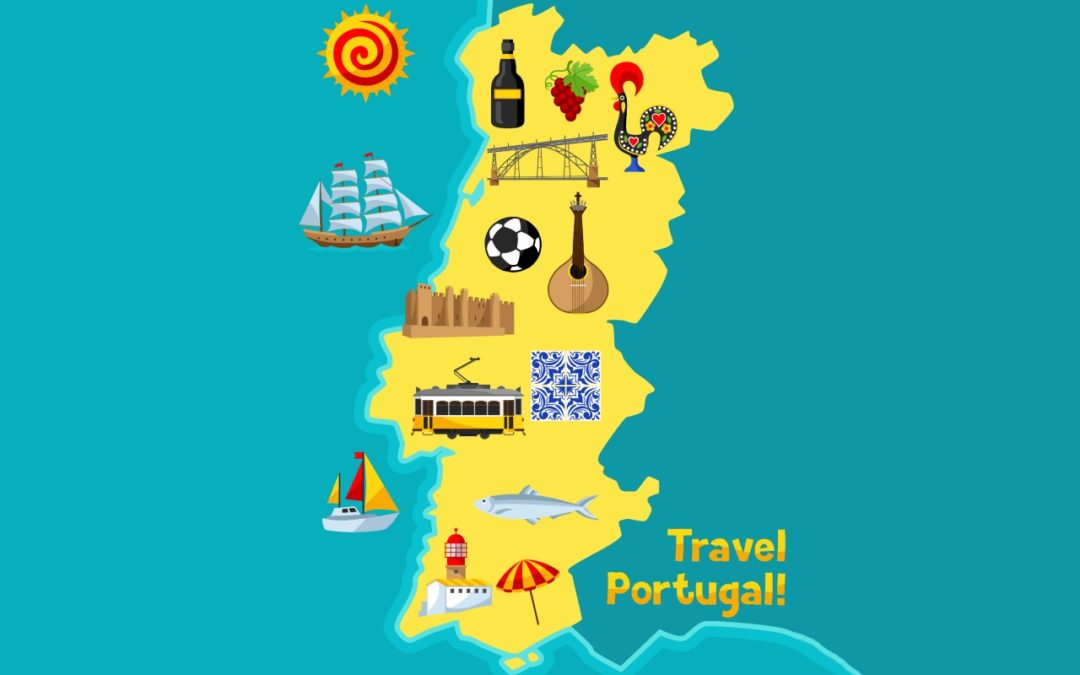Portugal is a country with a rich winemaking tradition and a diverse range of wine regions. From the port wine of the Douro region to the red wines of Alentejo, each region has its own unique character and style. In this blog, whilst the Road Butler mainly focuses on the Porto area, we’ll take a closer look at the main wine regions of Portugal and explore the grape varieties, winemaking traditions, and signature styles that make these regions so special. Whether you’re a wine lover looking to discover new regions or a traveler planning a trip to Portugal, this guide will provide you with a comprehensive overview of the country’s diverse wine regions.
Douro, Portugal Wine Region
The Douro wine region is located in the northern part of Portugal and is known for its red, white, and port wines. The region has a Mediterranean climate with hot, dry summers and mild winters, and the grapes are grown on terraced vineyards that are carved into the slopes of the Douro river valley. The region is protected by the Marão and Montemuro mountains, which help to shelter the vineyards from the Atlantic Ocean’s cool, moist air.
The Douro region is known for its grape variety Touriga Nacional, which is used to make full-bodied red wines with flavors of dark fruit and spice. The grape is known for its high tannin content and long aging potential. In addition to Touriga Nacional, the region is also home to other grape varieties such as Tinta Roriz, Touriga Franc, and Tinta Barroca, which are used to make red, white, and port wines. These grape varieties are often blended together to create complex and balanced wines.
The Douro region is also known for its production of port wine, which is made from grapes that are grown in the region and then aged in oak barrels. Port wine is a fortified wine, which means that it is made with the addition of a spirit, usually brandy, to stop the fermentation process and preserve the wine’s sweetness. The Douro region is home to a number of small, family-run wineries as well as larger, more commercial producers. Many of the wineries in the region offer wine tastings and tours, and some also have restaurants or accommodation on site, making them a great destination for a wine-themed holiday. The wines of the Douro region are known for their character and complexity, and they are often paired with local cuisine such as pork, lamb, and game dishes. If you’re planning a trip to Portugal and want to discover the wines of the Douro region, be sure to include a visit to a local vineyard on your itinerary.
Dão, Portugal Wine Region
The Dão wine region is located in the north-central part of Portugal and is known for its red wines made from grape varieties such as Touriga Nacional, Tinta Roriz, Alfrocheiro, and Jaen. The region has a Mediterranean climate with hot, dry summers and mild winters, and the grapes are grown on granite, shale, and schist soil. The region is named after the Dão river, which flows through the region and helps to shape its landscape and climate.
The Dão region is known for its tannic red wines, which are made from grapes that are grown at high altitudes and harvested late in the season. The wines of the Dão region tend to be full-bodied and have flavors of dark fruit, spice, and earth. In addition to red wines, the region also produces white, rosé, and sparkling wines made from grape varieties such as Encruzado, Malvasia Fina, and Bical. These grape varieties are often blended together to create complex and balanced wines.
In addition to wine, the Dão region is also known for its cheese, pork, and lamb dishes. The region is home to a number of small, family-run wineries as well as larger, more commercial producers. Many of the wineries in the region offer wine tastings and tours, and some also have restaurants or accommodation on site, making them a great destination for a wine-themed holiday. The wines of the Dão region are known for their character and complexity, and they are often paired with local cuisine such as pork, lamb, and game dishes. If you’re planning a trip to Portugal and want to discover the wines of the Dão region, be sure to include a visit to a local vineyard on your itinerary.
Bairrada Portugal Wine Region
The Bairrada wine region is located in the central part of Portugal and is known for its red, white, and sparkling wines. The region has a Mediterranean climate with hot, dry summers and mild winters, and the grapes are grown on clay and granite soil. The region is named after the báleas (bulls) that are traditionally used to plow the land, and the region’s emblem is the bull’s head.
The Bairrada region is known for its grape variety Baga, which is used to make full-bodied red wines with flavors of black fruit and spice. The grape is known for its high tannin content and long aging potential. In addition to Baga, the region is also home to other grape varieties such as Maria Gomes, Arinto, and Cercial, which are used to make white, sparkling, and rosé wines.
These grape varieties are often blended together to create complex and balanced wines.
The Bairrada region is also known for its production of cork, which is used to make wine bottle stoppers and other products. The region is home to a number of cork oak forests, and the cork industry is an important part of the local economy. In addition to cork and wine, the Bairrada region is also known for its seafood, particularly its bacalhau (dried salted cod) and its cataplana, a seafood stew that is traditionally cooked in a copper pot.
The Bairrada region is home to a number of small, family-run wineries as well as larger, more commercial producers. Many of the wineries in the region offer wine tastings and tours, and some also have restaurants or accommodation on site, making them a great destination for a wine-themed holiday. The wines of the Bairrada region are known for their character and complexity, and they are often paired with local cuisine such as pork, lamb, and seafood dishes. If you’re planning a trip to Portugal and want to discover the wines of the Bairrada region, be sure to include a visit to a local vineyard on your itinerary.
Alentejo Portugal Wine Region
The Alentejo region is located in the south-central part of Portugal and is known for its red, white, and rosé wines. The region has a Mediterranean climate with hot, dry summers and mild winters, and the grapes are grown on clay and limestone soil. The region is characterised by its rolling hills, olive groves, and cork oak forests, and the landscape is dotted with traditional whitewashed villages and castles.
The Alentejo region is known for its grape variety Alicante Bouschet, which is used to make full-bodied red wines with flavors of dark fruit and spice. The grape was introduced to the region in the 19th century and has since become one of the region’s signature grape varieties. In addition to Alicante Bouschet, the region is also home to other grape varieties such as Aragonez (Tempranillo), Trincadeira, and Antão Vaz, which are used to make red, white, and rosé wines.
In addition to wine, the Alentejo region is also known for its cork production and its olive oil. The region is home to a number of small, family-run wineries as well as larger, more commercial producers. Many of the wineries in the Alentejo region offer wine tastings and tours, and some also have restaurants or accommodation on site, making them a great destination for a wine-themed holiday. The wines of the Alentejo region are known for their character and complexity, and they are often paired with local cuisine such as pork, lamb, and game dishes. So, if you’re planning a trip to Portugal and want to discover the wines of the Alentejo region, be sure to include a visit to a local vineyard on your itinerary.
Vinho Verde, Portugal Wine Region
The Vinho Verde wine region is located in the northwest part of Portugal and is known for its white, rosé, and sparkling wines. The region has a temperate maritime climate with cool, wet winters and warm, dry summers, and the grapes are grown on granite and schist soil. The region is named after the wine (vinho verde) that is produced there, which means “green wine” in Portuguese.
The Vinho Verde region is known for its grape variety Alvarinho, which is used to make full-bodied white wines with flavors of citrus and stone fruit. The grape is grown in the Minho subregion of the Vinho Verde region and is often blended with other grape varieties such as Loureiro and Trajadura to create complex and balanced wines. In addition to white wines, the region also produces rosé and sparkling wines made from grape varieties such as Espadeiro and Padeiro.
The Vinho Verde region is also known for its production of green table wines, which are made from grape varieties such as Loureiro and Arinto. These wines are light, fresh, and low in alcohol, and they are meant to be consumed young. The Vinho Verde region is home to a number of small, family-run wineries as well as larger, more commercial producers. Many of the wineries in the region offer wine tastings and tours, and some also have restaurants or accommodation on site, making them a great destination for a wine-themed holiday. The wines of the Vinho Verde region are known for their freshness and versatility, and they are often paired with local cuisine such as seafood, poultry, and cheese dishes. If you’re planning a trip to Portugal and want to discover the wines of the Vinho Verde region, be sure to include a visit to a local vineyard on your itinerary.
In conclusion, Portugal is a country with a rich and diverse wine culture that offers something for every wine lover to discover. From the port wine of the Douro region to the refreshing whites of Vinho Verde, each region has its own unique character and style. Whether you’re a wine enthusiast looking to explore new regions or a traveler planning a trip to Portugal, there is something for everyone to enjoy. The main wine regions of Portugal – Douro, Dão, Bairrada, Alentejo, and Vinho Verde – are all worth exploring and offer a wealth of wine experiences to savor.

